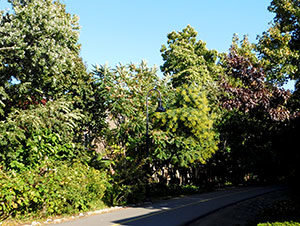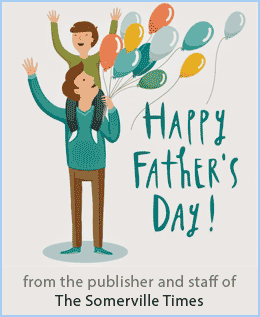(The opinions and views expressed in the commentaries and letters to the Editor of The Somerville Times belong solely to the authors and do not reflect the views or opinions of The Somerville Times, its staff or publishers)
*

By Amy Mertl
Assistant Professor of Biology, Lesley University
This past August, Chris Dwan and Renée Scott sounded the alarm at the increasing destruction of Somerville’s urban forest in their Somerville Times letter. As they argue, the loss of our tree canopy is concerning due to the many ecological benefits trees provide our city such as CO2 sequestration, storm water uptake, and climate change mitigation. However, recent studies have shown that our connection with urban trees is even more personal, with trees providing a wide range of health and social benefits. It is time that we consider our urban trees to be more than decorative ornaments to be removed when inconvenient, and instead view them as a vital public health resource that requires protection and support.
When we think of public health resources we typically think of programs like flu shot clinics, smoking cessation programs and regulations that ensure health drinking water: things that prevent disease, improve quality of life, and reduce health risks. Our urban trees also prevent disease, improve quality of life and reduce health risks in many remarkable ways.
Clean Air and Respiratory Health
In urban areas, trees are basically giant air purifiers. Urban air is full of toxic gases and particulate matter from car exhaust, home fuel use, dust, salt and industrial pollution. Trees effectively remove much of this pollution, either by accumulating it on their surfaces or absorbing it in through their leaves. A 2006 study looked at air pollution reduction by urban trees and estimated that in the Boston area alone trees save $1.47 million per year through removing ozone, particulate matter, sulfur dioxide, nitrogen dioxide and carbon monoxide. David Nowak and colleagues went even further in their 2014 study, where they estimated that air pollution removal by urban trees saves not only dollars but also lives. They calculated that urban trees prevent more than 850 deaths and 670,000 incidences of acute respiratory problems annually in the U.S. While the pollen of some tree species can exacerbate seasonal allergies, these are a subset of common urban tree species and are often non-native and/or wind-pollinated. With some thoughtful consideration to the natural history of the species used, urban trees can have an overall strongly positive affect on air quality and respiratory health.
Cardiovascular Heath and Disease
Urban trees have also been shown to save lives by improving our cardiovascular health and reducing the prevalence of disease. After the loss of some 100 million trees in the U.S. due to the emerald ash borer infestation in the 1990’s, researchers compared rates of cardiovascular disease with the magnitude of tree loss in different areas. The loss of these trees was associated with an additional 15,000 deaths from cardiovascular disease. Many other studies have demonstrated similar correlations between the abundance of urban trees and improved cardiovascular health, such as a large-scale study in Canada that found a strong correlation between urban tree abundance and improved cardiovascular, metabolic and mental health even after controlling for socioeconomic variation. The authors considered living on a city block with 10 additional street trees to have the same health benefits as being 7 years younger! While the reasons urban trees are linked to reduced cardiovascular disease are not entirely understood, in may be a combination of air quality improvements, stress relief and the promotion of physical activity when around urban trees.
Stress and Social Connections
Perhaps most surprisingly, urban trees have been shown to greatly reduce our stress and improve our feelings of being social connected to other people. The new concept of “forest bathing”, or spending time in forests in order to improve overall health, is based on recent research showing that certain compounds (called phytonicdes) that are naturally released by trees directly reduce our stress hormones and improve our immune system. Studies in urban environments have found complementary correlations between the density of trees and other green vegetation and reduced stress, with the greatest benefits often found in low-income neighborhoods and among seniors. Urban trees also improve our overall feelings of well-being by fostering increased social and neighborhood connections. Studies on public housing projects in the Chicago area found that more trees in outdoor common areas increased the use of outdoor spaces by residents and correlated with increased social activities and neighbor connections. Again, these studies suggest that thoughtful planning in the placement and density of urban trees can have massive impacts on our overall well-being and happiness.
The documented benefits of urban trees in terms of improved respiratory health, reduced cardiovascular disease, reduced stress and increased neighborhood connections clearly put urban trees in the category of public health resources. And more health benefits of urban trees are being described all the time: from reduced rates of car accidents on tree-lined streets, to a larger tree canopy being correlated with reduced crime rates. There is no need to wait for more evidence to accumulate before we start taking more dramatic steps to preserve our urban forest and the many public health benefits our trees provide. I support the recommendations given previously by Dwan and Scott to better preserve and expand Somerville’s urban canopy. As recently as last week, the Urban Forest Task Force in Cambridge reported an 18 % decrease in their tree canopy since 2009. We do not yet have comparable data on Somerville’s tree canopy loss, but given our current rates of urban development we are most likely experiencing a similar rate of canopy loss. I would therefore add to the previous recommendations by Dwan and Scott that our urban trees should be considered a public health resource, to be reviewed, funded, documented and protected as such.
*
References:
Dwan C. and Scott R. “Protect our urban forest”. The Somerville Times, August 15th 2018.
Nowak, D., Crane D., and Stevens J. “Air pollution removal by urban trees and shrubs in the United States.” Urban forestry & urban greening (2006): 115-123.
Nowak, D. J., Hirabayashi, S., Bodine, A., and Greenfield, E. “Tree and forest effects on air quality and human health in the United States”. Environmental Pollution (2014): 193, 119-129.
Donovan, G. H., Butry, D. T., Michael, Y. L., Prestemon, J. P., Liebhold, A. M., Gatziolis, D., and Mao, M. Y. “The relationship between trees and human health: evidence from the spread of the emerald ash borer”. American journal of preventive medicine (2013) 44(2), 139-145.
Li, Q. “Effect of forest bathing trips on human immune function”. Environmental health and preventive medicine (2010) 15(1), 9.
Thompson, C. W., Roe, J., Aspinall, P., Mitchell, R., Clow, A., and Miller, D. “More green space is linked to less stress in deprived communities: Evidence from salivary cortisol patterns”. Landscape and urban planning (2012) 105(3), 221-229.
Takano, T., Nakamura, K., and Watanabe, M. “Urban residential environments and senior citizens’ longevity in megacity areas: the importance of walkable green spaces”. Journal of Epidemiology & Community Health (2002) 56(12), 913-918.
Coley, R. L., Sullivan, W. C., and Kuo, F. E. “Where does community grow? The social context created by nature in urban public housing.” Environment and behavior (1997) 29(4), 468-494.
Kuo, F. E., Sullivan, W. C., Coley, R. L., and Brunson, L. “Fertile ground for community: Inner-city neighborhood common spaces”. American Journal of Community Psychology (1998) 26(6), 823-851.
Dumbaugh, E., and Gattis, J. L. “Safe streets, livable streets”. Journal of the American Planning Association (2005)71(3), 283-300.
Troy, A., and Grove, J. M. “Property values, parks, and crime: A hedonic analysis in Baltimore, MD”. Landscape and urban planning (2008) 87(3), 233-245.
Levy, M. “City lost 18 percent of tree canopy since 2009, according to report to urban forest task force.” Cambridge Day, September 29th, 2018.


















Reader Comments